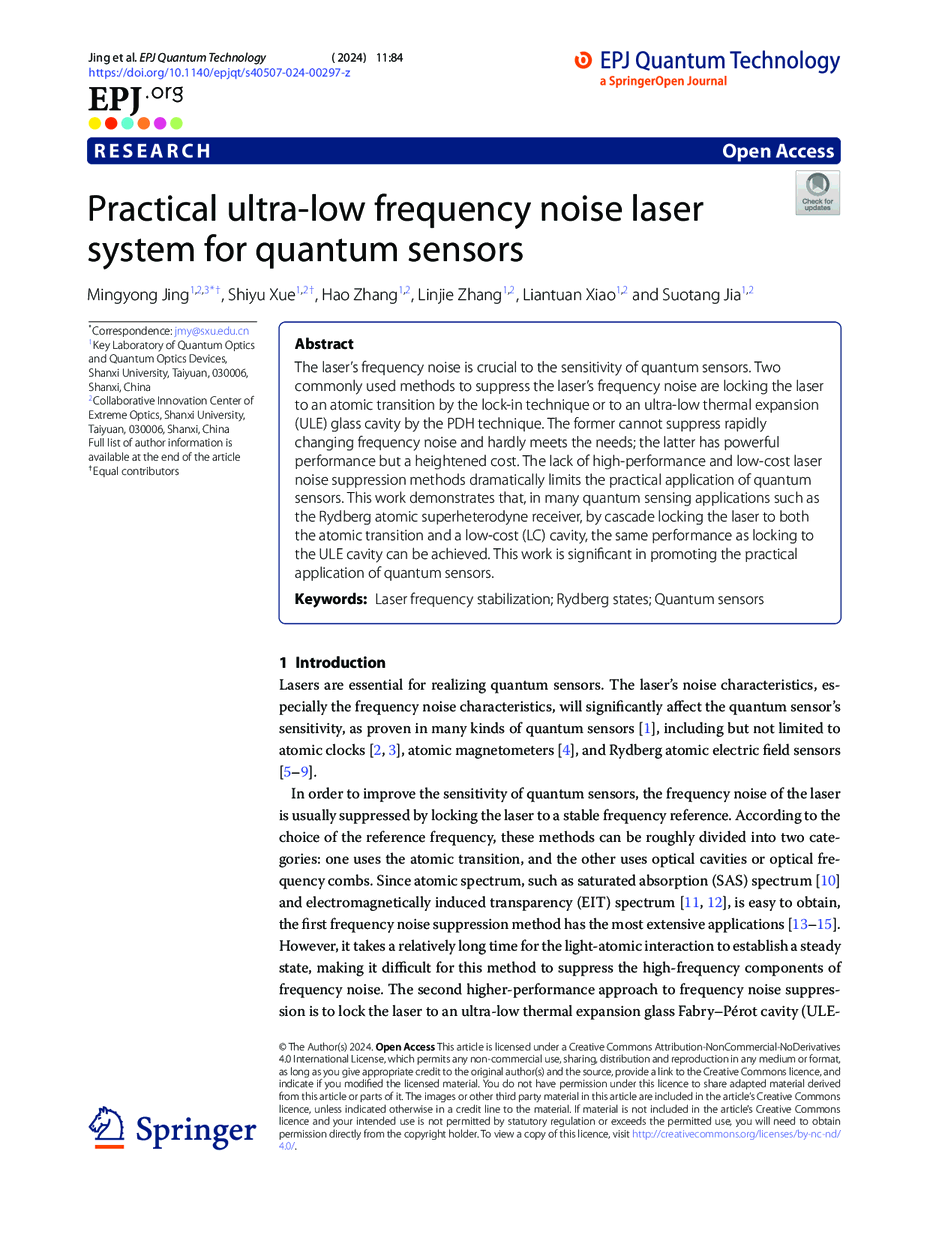https://doi.org/10.1140/epjqt/s40507-024-00297-z
Research
Practical ultra-low frequency noise laser system for quantum sensors
1
Key Laboratory of Quantum Optics and Quantum Optics Devices, Shanxi University, 030006, Taiyuan, Shanxi, China
2
Collaborative Innovation Center of Extreme Optics, Shanxi University, 030006, Taiyuan, Shanxi, China
3
Department of Precision Instrument, Tsinghua University, 100084, Beijing, China
Received:
17
April
2024
Accepted:
4
December
2024
Published online:
19
December
2024
The laser’s frequency noise is crucial to the sensitivity of quantum sensors. Two commonly used methods to suppress the laser’s frequency noise are locking the laser to an atomic transition by the lock-in technique or to an ultra-low thermal expansion (ULE) glass cavity by the PDH technique. The former cannot suppress rapidly changing frequency noise and hardly meets the needs; the latter has powerful performance but a heightened cost. The lack of high-performance and low-cost laser noise suppression methods dramatically limits the practical application of quantum sensors. This work demonstrates that, in many quantum sensing applications such as the Rydberg atomic superheterodyne receiver, by cascade locking the laser to both the atomic transition and a low-cost (LC) cavity, the same performance as locking to the ULE cavity can be achieved. This work is significant in promoting the practical application of quantum sensors.
Key words: Laser frequency stabilization / Rydberg states / Quantum sensors
© The Author(s) 2024
 Open Access This article is licensed under a Creative Commons Attribution-NonCommercial-NoDerivatives 4.0 International License, which permits any non-commercial use, sharing, distribution and reproduction in any medium or format, as long as you give appropriate credit to the original author(s) and the source, provide a link to the Creative Commons licence, and indicate if you modified the licensed material. You do not have permission under this licence to share adapted material derived from this article or parts of it. The images or other third party material in this article are included in the article’s Creative Commons licence, unless indicated otherwise in a credit line to the material. If material is not included in the article’s Creative Commons licence and your intended use is not permitted by statutory regulation or exceeds the permitted use, you will need to obtain permission directly from the copyright holder. To view a copy of this licence, visit http://creativecommons.org/licenses/by-nc-nd/4.0/.
Open Access This article is licensed under a Creative Commons Attribution-NonCommercial-NoDerivatives 4.0 International License, which permits any non-commercial use, sharing, distribution and reproduction in any medium or format, as long as you give appropriate credit to the original author(s) and the source, provide a link to the Creative Commons licence, and indicate if you modified the licensed material. You do not have permission under this licence to share adapted material derived from this article or parts of it. The images or other third party material in this article are included in the article’s Creative Commons licence, unless indicated otherwise in a credit line to the material. If material is not included in the article’s Creative Commons licence and your intended use is not permitted by statutory regulation or exceeds the permitted use, you will need to obtain permission directly from the copyright holder. To view a copy of this licence, visit http://creativecommons.org/licenses/by-nc-nd/4.0/.





